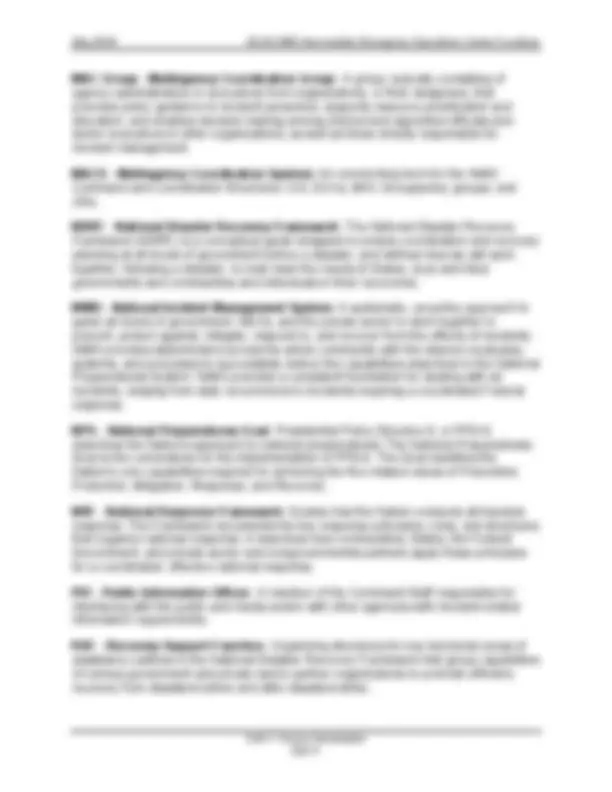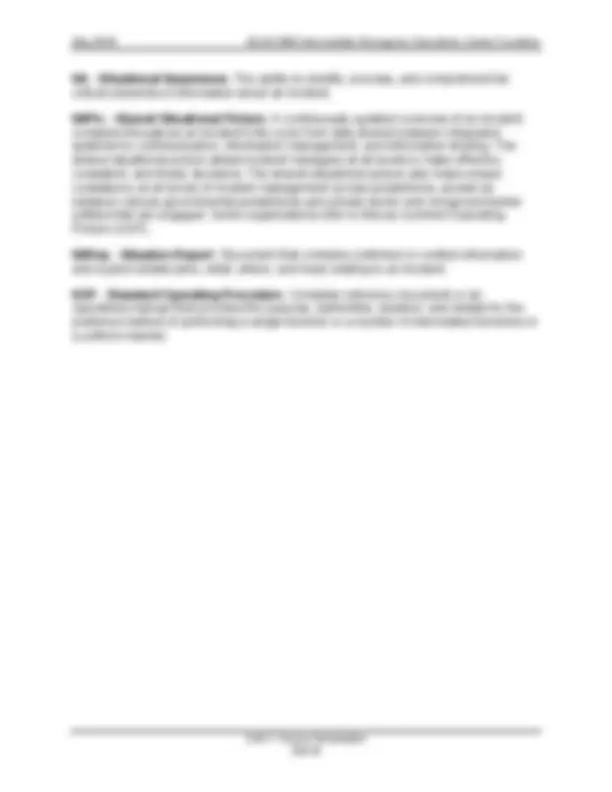




Study with the several resources on Docsity

Earn points by helping other students or get them with a premium plan


Prepare for your exams
Study with the several resources on Docsity

Earn points to download
Earn points by helping other students or get them with a premium plan
Community
Ask the community for help and clear up your study doubts
Discover the best universities in your country according to Docsity users
Free resources
Download our free guides on studying techniques, anxiety management strategies, and thesis advice from Docsity tutors
An introduction to the intermediate emergency operations center (eoc) functions course, focusing on common acronyms and glossary terms. It covers the concept of continuity of operations (coop), the role of eocs, and the incident command system (ics). The document also introduces various structures such as the incident command post (icp), incident management team (imt), and multiagency coordination group (mac).
Typology: Lecture notes
1 / 4

This page cannot be seen from the preview
Don't miss anything!



Unit 1: Course Introduction
Handout 1-1: Common Course Acronyms and Glossary
COOP - Continuity of Operations : Continuity of Operations, as defined in the National Security Presidential Directive-51/Homeland Security Presidential Directive-20 (NSPD- 51/HSPD-20) and the National Continuity Policy Implementation Plan (NCPIP), is an effort within individual executive departments and agencies to ensure that Primary Mission Essential Functions (PMEFs) continue to be performed during a wide range of emergencies, including localized acts of nature, accidents, and technological or attack- related emergencies.
Departmental EOC Structure: Jurisdictions/organizations may opt to use their day-to- day departmental/agency structure and relationships in their EOC. By operating in the context of their normal relationships, department/agency representatives can function in the EOC with minimal preparation or startup time. In this configuration, the organization’s emergency manager or a senior official typically coordinates EOC efforts among the departments and agencies.
DRC - Disaster Recovery Center : A facility established in a centralized location within or near the disaster area at which disaster survivors (individuals, families, or businesses) may apply for disaster aid.
EOC - Emergency Operation Center : The physical location at which the coordination of information and resources to support incident management (on-scene operations) activities normally take place. An EOC may be a temporary facility or may be located in a more central or permanently established facility, perhaps at a higher level of organization within a jurisdiction.
EOP - Emergency Operations Plan: A plan for responding to a variety of potential hazards.
ESF - Emergency Support Function : The grouping of governmental and certain private sector capabilities into an organizational structure to provide capabilities and services most likely needed to manage domestic incidents.
IAP - Incident Action Plan: An oral or written plan developed and approved by the IC/UC and ICS staff. The IAP contains general objectives reflecting the overall strategy for managing an incident. It may include the identification of operational resources and assignments. It may also include attachments that provide direction and important information for management of the incident during one or more operational periods.
Staff in EOCs conduct iterative planning and produce plans to guide their activities during specified periods. These are typically more strategic than IAPs, and should not be referred to as an IAP to avoid confusion. Incident Support Plan (ISP) is a term that some EOCs use for the EOC plan to clearly differentiate this from the Incident Action Plan.
Unit 1: Course Introduction
ICS - Incident Command System : A standardized on-scene emergency management construct specifically designed to provide for the adoption of an integrated organizational structure that reflects the complexity and demands of single or multiple incidents, without being hindered by jurisdictional boundaries. ICS is a management system designed to enable effective incident management by integrating a combination of facilities, equipment, personnel, procedures, and communications operating within a common organizational structure, designed to aid in the management of resources during incidents.
ICS or ICS-Like EOC Structure: Many jurisdictions/organizations configure their EOCs using the standard ICS organizational structure. The structure is familiar to many people, and it aligns with the on-scene incident organization. Some jurisdictions/organizations use the standard ICS organizational structure but modify certain titles to create an ICS-like organization that distinguishes EOC functions from their field counterparts.
ICP - Incident Command Post: The field location where the primary functions of incident command are performed. The ICP may be co-located with the Incident Base or other incident facilities.
IMT - Incident Management Team : A rostered group of ICS-qualified personnel consisting of an Incident Commander, Command and General Staff, and personnel assigned to other key ICS positions.
ISM – Incident Support Model EOC Structure: Jurisdictions/organizations that focus their EOC team’s efforts on information, planning, and resource support may choose to separate the situational awareness function from planning and combine operations and logistics functions into an incident support structure. This organization puts the EOC director in direct contact with those doing situational awareness/information management and streamlines resource sourcing, ordering, and tracking.
JFO - Joint Field Office: The primary Federal incident management field structure. The JFO is a temporary Federal facility that provides a central location for the coordination of local, state, tribal, and Federal governments and private sector and NGOs with primary responsibility for response and recovery.
JIC - Joint Information Center : An interagency entity established to coordinate and disseminate information for the public and media concerning an incident.
JIS - Joint Information System : Mechanism that integrates incident information and public affairs into a cohesive organization designed to provide consistent, coordinated, accurate, accessible, timely, and complete information during crisis or incident operations.
Unit 1: Course Introduction
SA - Situational Awareness : The ability to identify, process, and comprehend the critical elements of information about an incident.
SitPic - Shared Situational Picture : A continuously updated overview of an incident compiled throughout an incident’s life cycle from data shared between integrated systems for communication, information management, and information sharing. The shared situational picture allows incident managers at all levels to make effective, consistent, and timely decisions. The shared situational picture also helps ensure consistency at all levels of incident management across jurisdictions, as well as between various governmental jurisdictions and private-sector and nongovernmental entities that are engaged. Some organizations refer to this as Common Operating Picture (COP).
SitRep - Situation Report : Document that contains confirmed or verified information and explicit details (who, what, where, and how) relating to an incident.
SOP - Standard Operating Procedure : Complete reference document or an operations manual that provides the purpose, authorities, duration, and details for the preferred method of performing a single function or a number of interrelated functions in a uniform manner.